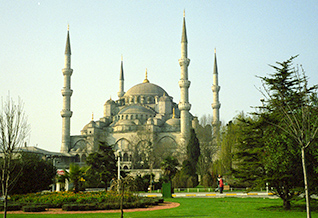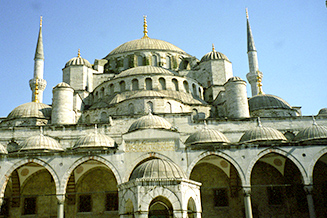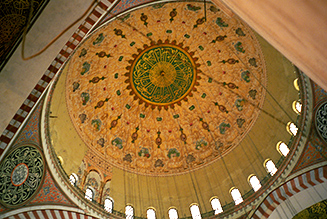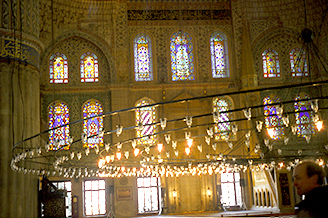Western Turkey
Day 4 - Saturday, 4 April 1998
The next morning as we were taking a walk after breakfast, a woman leaned out the third story window of an old building, vigorously shaking out a sheet, perhaps a bedspread. She posed for a moment, looking out at the animals, and we really wanted to take a picture, but weren't sure if it was o.k. We didn't want to offend. Later we asked Meli, and she told us it would have been fine. "If they don't want their picture taken, they will let you know." "It is a good idea," she said, "to point to the camera and ask, 'Picture?' Then don't be surprised if they, especially the children, start saying 'Address, address!' " They want to give you their address so you can send a copy of any pictures of them you take of them.
About lunch time we we bought two simits from a street vendor. Jim called them Turkish bagels. We ask him how much and he indicated they were 200,000 each. That must be the "tourist price." We ordered two and Jim gave him a 500,000 TL bill. He ask for another 500,000 bill for the second simit. Jim responded with a rather sharp NO! The vendor waved us off as if we had just robbed him. We suspect a local person would have paid no more than 50,000 for each bread ring. We had just paid 500,000 for two and decided that we should make sure we always had smaller bills so change would not be necessary.
We walked across the street and bought two cans of Coke for the posted price of 150,000 each (about 60 cents). Jim paid with a 1,000,000 bill and got the correct change of 700,000 with no problem.
Back by the hotel we picked up four oranges at the same little market we had visited two days before. This time three little girls were minding the store. Previously we dealt with an older man. The girls weighed the oranges, talked among themselves and ask for 300,000 lira. Based on what we had paid two days earlier we felt that was a bit high. After some bargaining we settled for 200,000. We felt uncomfortable dickering with three girls who were probably around 10 years old but we would have felt even worse if we had not tried to get a more reasonable price.
Our hotel host at Otel Aya Sofya served us apple tea and instructions on how to avoid getting lost. Although we were members of the same tour, on this first day we were still strangers to one another, and we spread out on our own, sometimes two couples joining together.
Our tour was scheduled to officially begin at 5 pm. Julie, Raquella, and Mahmut had arrived but Meli's plane was late, so we started without her. Apple tea was served as we all sat around the hotel lobby. Julie explained the community journal process. Nancy Spengler agreed to be the journal monitor and make sure it was properly passed on each day. We volunteered to be the editors. Tour members will take turns keeping notes and writing the day's happenings in the journal. The editors' job is to type, proof and make sure everyone gets a copy.
Suddenly it seemed as if a wind had blown the door open and Meli came in, in high heels and high gear, talking as she headed for her seat. Our first glimpse of Meli was of this burst of energy that rearranged the atmosphere around herself. She poured out information and stories, including a story about the other Otel Sofya just down the street, and the missing body of a wealthy person.
Our little hotel seems to have been at the very heart of a drama, a competition between businessmen. The other hotel owners apparently concocted an elaborate scheme; first to try to get money to upgrade their hotel, then to discredit our Otel Sofya, but it backfired. They had stolen the body from its grave, and demanded money for its return. They were discovered, and their hotel is now closed. I'm not certain what happened to the body of the wealthy person that had been stolen. Hopefully he was returned to rest in peace.
Blue Mosque

Very soon we were on our feet and trying to keep up with Meli the dynamo who set off at high speed toward the Blue Mosque. When we finally all caught up to her, she told us she deliberately walked fast to time us, and to see if we could keep up. But she promised she would always stop and wait, so no one gets lost.
We found that frequently Meli would tell us something, and then say "remember" because it will come up later. She was not kidding. All the layers of history are spread out across this fabulous country and bits and pieces are found in all kinds of places. Meli began uncovering the layers for us at the Blue Mosque. "Observe," she commanded, "the cascade of the domes. Look for the harmony." This is something repeated many times. The harmony in architecture is a theme we will see everywhere we go.
We didn't have to cover our hair with scarves in this mosque, but we did have to take our shoes off and put them in plastic bags before we were allowed to step on the carpet. It's a balancing act, to take off your shoe between the time you lift your foot from the concrete and set it down on the carpet, then repeat with the other foot. During the trip there were a few other opportunities to practice this art. (Keeping the plastic bag in our daypacks was also a good idea. Not all mosques have them, and you don't really want to leave your shoes piled by the door, nor do you want to carry your dirty shoes in one hand. And they will get very dirty!)
A Meli rule is that when we go into a site, we are to first listen to her lecture and take pictures afterwards. She wasn't always successful at getting us all together for the lectures, but having this rule did help keep most of us together.
In the Blue Mosque, our first lecture told us the story of Ahmet I. He became sultan in 1603 at age 12. At age 18 he decided he wanted to build a mosque with grandeur greater than of Hagia Sophia. Ahmet was despondent because he knew of no one who could design and build such a grand structure since Sinan the great architect was now dead. Ahmet I had a wise vizier, however, who told him that he had such a man, who knew math and geometry, who was a poet, a musician, and an experienced artist in mother-of-pearl, and who had been an apprentice of Sinan.
This architect was summoned and set to the task. The grandeur of the mosque, according to the philosophy of the architect, was more than just size. He imported fine marble from Anatolia, and beautiful tiles from Iznik. He built 283 beautiful stained glass windows, and put six minarets around the mosque. In addition to the large central dome, he built smaller domes cascading all around. The entire mosque is a harmony of form and design, extending even to the outer court where there are colonnaded domes for the masses of people who would be unable to get inside during special events.

Meli told a story about the minarets. The sultan told the architect that he wanted the minarets to be "fortin" or gold. The architect claimed he misunderstood and thought the sultan had said "forta" or six. So now there was a problem. The mosque at Mecca had six minarets, and it would seem that Ahmet's mosque was now greater than that of Mecca. So the Sultan arranged for a seventh minaret to be built on the mosque at Mecca, and made the architect responsible to see that it happened.
While marble was being brought from Anatolia, it became clear that a road was needed, and so that was built also. Tiles, the beautiful turquoise blue tiles, were brought from Iznik. The Iznik tiles are made of quartz, so they are glass rather than clay. It is from these lovely tiles that the mosque gets its popular name, the Blue Mosque.

The most difficult part was the central dome. The architect was worried about whether he would be able to accomplish it, and prayed to Sinan for help. The answer came, "That is why we have apprentices. Do what you know, and it will work."
Meli pointed out to us one of her "remember" items. In one dome there is a green medallion with a double cross overlapping. "Remember it," she says, "you will see it again."
The Blue Mosque was built during the years 1609 - 1616. Ahmet I died in 1618 at age 27. He had built his monument, as Meli says emperors do, according to his own ego.
Meli turned away from history for a moment to take a pulse of the people around her. "Why are each of you on this tour?" she asked and continued without waiting for an answer, "How many would like to learn about Islam?" She called for a show of hands. Many hands went up, and the lecture moved smoothly from a history lesson to a lesson in religion, blended in with the architecture of the building in which we stood. The stone floor under our feet was cold, and some were feeling the cold acutely, but we all remained to hear the next part.
It is part of Islamic belief that a human being is a masterpiece of perfect art. We are made in the image of God, we are His workmanship, and we should not feel ourselves to be inferior to Him, but rather a reflection of Him, as well as His creation. The construction of domes in churches and mosques places God symbolically at the top - it is considered to be the "seat of God."

Someone asked Meli about the placement of strings of lights not far above our heads across the mosque. "The lights," she tells us now, "are placed low to help us to not feel insignificant." (Some of us would rather have had the openness of the dome, because the strings of lights mar the beauty of a photograph, like telegraph poles and wires do in a landscape. Some perhaps, would have liked to have that feeling of insignificance against such a marvelous backdrop.)
Islam is iconoclastic, Meli says, meaning no human figures can be represented. That is why the art in the mosques is geometric, and has symbolic rather than literal interpretations of spiritual meanings. There is a sign over the entry in Arabic which Meli translates for us, "The best worship is working," a philosophy which lends value to the everyday tasks of life.
Meli told us a story about the restoration work that was done on the Blue Mosque, which took 17 years to complete. Buttresses that were required to support the dome have blocked some of the 283 beautiful stained glass windows that represent the "light of enlightenment".
Over the years, a great many beautiful carpets had been layered on top of each other on the floor. During the restoration a decision was made to replace them with a matching design across the entire floor. The new design is logical, the design being perfectly proportioned for a praying person to always know where the feet go and where the head goes, but to Meli it is very sad.
She told us that when she came in during the reconstruction and saw all those beautiful carpets piled carelessly in a corner, she cried for a month. "Those carpets for all these 400 years listened to the prayers and received the tears of all the people who came here to pray. And they just threw them out." We were beginning to see the passion of Meli as she shared some of her deepest feelings with us.
As we were leaving, she pointed out the symbol of the tree of life that is depicted over the door. She mentioned its significance as recorded in the Book of Genesis, as well as in the Book of Revelation's letter to the church at Ephesus. It is one of those "you'll see it again" things. The tree of life is ubiquitous in the art of carpets, pottery and mosaics of the Anatolian region.
The shops outside and near the mosque support the mosque, Meli told us. But they do not take in enough money to take care of all the needs.
We played the name game outside. Still strangers to each other, we began to know at least what name each one is called.
Dinner was in a lovely old home that has been converted to a restaurant. It has, of course, a story to tell, and Meli the storyteller told it well. The man who lived here was an artist who created many beautiful paintings. After he died, his wife would not part with his paintings, nor let them be taken away. Her children decided to make the home a restaurant, leaving their father's art on the walls. So they did it, and then learned how to run a restaurant.
Salads, bread and bottles of water were already on the tables when we arrived. "The water is included," Meli said, but any other beverages are at our own expense. As each course was served, she described what we were eating. This was to be her standard for the entire trip. And it's a good thing. Most of the meals are unfamiliar dishes to we Americans, but all the food is delicious. Sometimes we complained that we were given too much! Perhaps our strongest complaint, especially during the early part of the trip was that meals come so late. It was not that we were going hungry, it was because we Americans are accustomed to eating early and digesting our food prior to going to bed. Some of us have trouble sleeping when go to bed with a full stomach. It is one thing I don't think Meli really understood about us.
The Turkish way seems to be big meals, late at night, eaten slowly, and stay up even later. But maybe they have siestas in the heat of the afternoon. That is their lifestyle, and they are as accustomed to it as people at the North Pole are to 6 months of night and 6 months of sunshine. We, on our whirlwind tour, do not have time for afternoon naps, and two weeks is not enough time for us to adjust our eating habits quite so drastically.
But the tour was on, and there were more things to see and do and learn and experience than we could possibly cram into the days allotted to us. So we groused about late dinners but we were not late for breakfast! There was much more yet to come. We took our vitamins, rested when we could, and tried to stay healthy. Unfortunately one tour member brought a virus from home. Eventually most members of the group came down with varying degrees of illness.